
Anticlines = folds pointing upwards.

Anticlines = folds pointing upwards.
Synclines = folds pointing downwards.
Limbs = sides or flanks of folds.Hinge line = where the limbs of the fold meet. It is also the line of maximum curvature.
Anticline: older beds are in the core (center) of the fold and the beds dip away from the core.Plunging Fold: has an inclined hinge line.
Syncline: younger beds are in the core of the fold and the beds dip into the core.
Plunging Anticline: beds point in the direction of the plunge; older beds are in the core (center) of the fold and the beds dip away from the core. Check out this classic example from Utah.Plunging and non-plunging anticlines and synclines can be represented in 3D block diagrams to show how the folded strata behave beneath the surface.
Plunging Syncline: beds point in the opposite direction of the plunge; younger beds are in the core of the fold and the beds dip into the core.